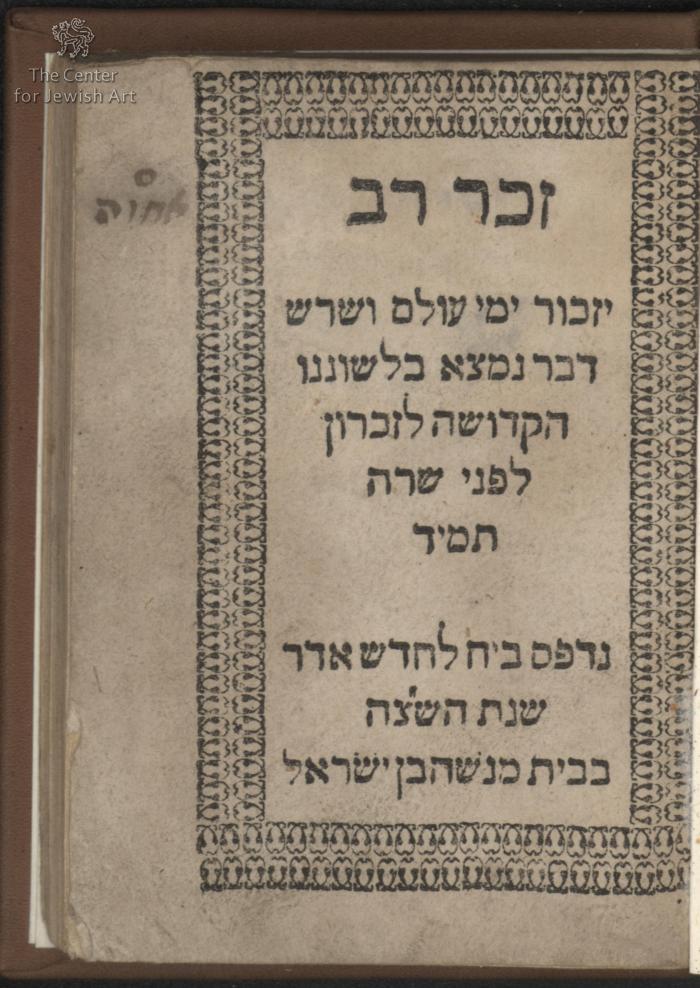Obj. ID: 35323 Zecher Rav by Binyamin Mosfia, Amsterdam, 1635

sub-set tree:
The following description was prepared by William Gross:
A versified philological work praising creation, in which all roots are used only once. R. Benjamin ben Immanuel Mussafia (Dionysius, 1606 – 1675), related to R. Menasseh Ben Israel by marriage, is believed to have been born in Spain to a Marrano family, removing to Hamburg where he became physician-in-ordinary to Christian IV of Denmark. When that monarch died in 1648, Mussafia relocated first to Glckstadt in Holstein and then to Amsterdam, where he spent the remainder of his life and served among the leaders of the Sephardic community. In addition to his Talmudic scholarship, Mussafia was a philologist competent in Latin, Greek, and Arabic. He was also, at one time, an enthusiastic advocate of Shabbatei Tzvi, but later repudiated his support for him.
The text of Zecher Rav is divided into seven parts, reflecting the seven days of creation. It was cleverly written in such a way that all of the three-letter roots of biblical Hebrew words and most of their derivatives appear only one time. The work has been reprinted at least 14 times, including translations and a Karaite adaptation. It is Mussafia’s first published work.
The book’s title page is adorned with a decorative frame made up of rows of florets. The small size of the book assured its present rarity as such small publications did not survive well over the centuries.
Menasseh ben Israel was one of the great figures of Sephardic Jewry, not only for his printing activities, but also for his erudite knowledge, his writings and his role as spokesman for his people. His father had thrice escaped death in Lisbon, Portugal, and resettled in Amsterdam to start life anew. Menasseh was given the best possible education in the Sephardic tradition. He studied under Chacham Isaac Uziel in the newly established Yeshiva in Amsterdam and excelled in his Talmudic studies and in his thorough knowledge of the Bible. At the astonishingly young age of 18 years he was appointed to the Rabbinical Council of Amsterdam, consisting of four members. A gifted orator and well versed in secular knowledge and culture, Menasseh was soon the most popular preacher in the new world center of Sephardic Jewry.
His fame as a scholar and as an expert on all matters of learning and science spread far beyond Holland. Some of the greatest scholars of the world sought his friendship and advice. The Queen of Sweden, Christina (the daughter of Gustaf Adolf), the painter Rembrandt, and the statesman and philosopher Hugo Grotius, were among his non-Jewish correspondents and friends. Yet, with all his secular knowledge and fame, Menasseh ben Israel devoted most of his time and interest to Jewish studies and to the defense of the Bible against many critics.
Poverty caused Menasseh ben Israel to turn his attention at least temporarily to practical business. He established the first Hebrew printing press in Holland, and was the father of the great printing and publishing tradition of Amsterdam, from which stemmed some of the best editions of the Tanach, the Talmud, and many other important volumes of Hebrew literature. In time, it became a flourishing business.
Menasseh earned his greatest merits as a spokesman for his Jewish brethren. He used his friendship with Queen Christina to induce her to consider the opening of Scandinavia as a haven of refuge for the thousands of Jewish refugees who were still wandering from one country to another, driven from place to place, deprived of their last possessions by greedy rulers and their still greedier subjects. He almost succeeded, when Christina abdicated from the throne. Yet Menasseh ben Israel did not abandon his hopes for providing new havens for his brethren. His attention now centered on England. In 1650 Menasseh sent a petition to the English Parliament to officially grant the readmission of Jews. He dedicated to it his manuscript called "The Hope of Israel." Menasseh expressed the wish to be permitted to visit England and defend in person the cause of the Jews. This permission was granted to him; but the outbreak of hostilities between England and Holland postponed his trip to Britain for more than five years.
In October 1655, Menasseh ben Israel landed in London. After his arrival he presented to Oliver Cromwell, then the strong man of England, a memorandum in which he refuted the prejudices against the Jews and pointed out the advantages that England could derive from granting them permission to resettle in England and live according to the commands of their religion. Cromwell sponsored this petition warmly, but the British clergy and the wealthy merchants, who were afraid of competition, did everything in their power to prevent its realization. In order to clear his brethren from the flood of false accusations brought up by their enemies, Menasseh ben Israel wrote his famous "Salvation of the Jews," in which he praised the faith and courage of the Jewish people throughout their history.
Menasseh ben Israel succeeded eventually. Cromwell granted many individual Jews the right to settle in London. Menasseh himself was honored by the British Protector and sent off with a farewell present of an annual stipend of 100 Sterling pounds. However, on the way back to Amsterdam, this great defender of the Jewish faith and the Jewish people died. He was laid to rest at the Jewish cemetery in Amsterdam.



